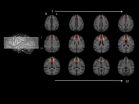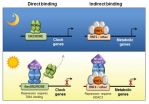(Press-News.org) La Jolla, Calif., June 4 -- In a scientific discovery that has significant implications for preventing HIV infections, researchers at Sanford-Burnham Medical Research Institute (Sanford-Burnham) have identified a protein that could improve the body's immune response to HIV vaccines and prevent transmission of the virus.
The study shows how a protein called polyglutamine-binding protein 1 (PQBP1) acts as a front-line sensor and is critical to initiating an immune response to HIV. When the PQBP1 encounters the virus, it starts a program that triggers an overall protective environment against infection and enhances the production of virus-specific antibodies. The research, which identified PQBP1 as a target for improving HIV vaccines, was published June 4 online ahead of print in the journal Cell.
'Vaccines work by teaching the immune system to react by mimicking a natural infection,' said lead author Sunnie Yoh, Ph.D., a postdoctoral fellow in the lab of Sumit Chanda, Ph.D., director of the Immunity and Pathogenesis Program at Sanford-Burnham. 'Designing a drug that mimics the interface between HIV and PQBP1 would allow an HIV vaccine to more effectively re-create an immune environment that mirrors real infection.'
'Current approaches to HIV vaccine development have thus far yielded little fruit, partly because of the lack of an effective vaccine adjuvant. Adjuvants promote a robust immune response to vaccines and are critical to eliciting long-lasting immunity,' said Chanda. 'Our study identifies a promising new target for a vaccine adjuvant that could advance the development of HIV vaccines and prevent infection.'
How it works
Although the major target of HIV infection is CD4+ T cells, dendritic cells are one of the first cell types to encounter HIV during sexual transmission. After HIV infects cells, its DNA forms an interface with PQBP1 in sentinel dendritic cells and initiates the immune response.
Dendritic cells control the innate immune response -- a generic, non-specific defense against pathogens. These cells also activate the adaptive immune response that generates highly specific antibodies that provide protective, long-lasting immunity. Both the innate and adaptive immune systems are necessary to provide an optimal immune response to vaccines.
'PQBP1 acts as a sentry for innate immune response to HIV. The development of a highly effective HIV vaccine will likely depend on both combining the correct immunogens, which are viral proteins, and unlocking the innate response, to establish long-lived protection,' said Chanda. 'Now that we know the gatekeeper, it will be much easier to find a key.'
INFORMATION:
The study was performed in collaboration with the Department of Chemistry, University of Michigan; the Department of Microbiology, and Global Health and Emerging Pathogens Institute, and the Department of Medicine, Division of Infectious Diseases, Icahn School of Medicine at Mount Sinai; Paul-Ehrlich-Institut, Germany; Hôpital Robert Debré, Service de Neurolgie Pédiatrique et Pathologie Métabolique, Paris; Sorbonne Paris Cité, Université Paris Diderot, Paris; Université of Lyon, France; German Center for Infection Research, Germany.
This study was funded by NIH grants CA177322-2, AI090935-03, AI1050184 and AI106754, and the James B. Pendleton Charitable Trust.
ABOUT SANFORD-BURNHAM MEDICAL RESEARCH INSTITUTE
Sanford-Burnham Medical Research Institute is dedicated to discovering the fundamental molecular causes of disease and devising the innovative therapies of tomorrow. Sanford-Burnham takes a collaborative approach to medical research with major programs in cancer, neurodegeneration and stem cells, diabetes, and infectious, inflammatory, and childhood diseases. The Institute is recognized for its National Cancer Institute designated Cancer Center, and expertise in drug discovery technologies. Sanford-Burnham is a nonprofit, independent institute that employs more than 1,000 scientists and staff in San Diego (La Jolla), Calif., and Orlando (Lake Nona), Fla. For more information, visit us at www.sanfordburnham.org.
Sanford-Burnham can also be found on Facebook and on Twitter.
ANN ARBOR--African-American women are equally, if not more, likely to experience infertility than their white counterparts, but they often cope with this traumatic issue in silence and isolation, according to a new University of Michigan study.
African-American women also more often feel that infertility hinders their sense of self and gender identity.
The U-M study may be among the first known to focus exclusively on African-American women and infertility. Most research has been conducted on affluent white couples seeking advanced medical interventions.
"Infertile ...
ATLANTA--The ability to delay gratification in chimpanzees is linked to how specific structures of the brain are connected and communicate with each other, according to researchers at Georgia State University and Kennesaw State University.
Their findings were published June 3 in the Proceedings of the Royal Society B: Biological Sciences.
This study provides the first evidence in primates, including humans, of an association between delay of gratification performance and white matter connectivity between the caudate and the dorsal prefrontal cortex in the right hemisphere, ...
A tougher federal standard for ozone pollution, under consideration to improve public health, would ramp up the importance of scientific measurements and models, according to a new commentary published in the June 5 edition of Science by researchers at NOAA and its cooperative institute at the University of Colorado Boulder.
The commentary, led by Owen Cooper of the Cooperative Institute for Research in Environmental Sciences and NOAA's Earth System Research Laboratory, looks at how a new, stricter ozone standard would pose challenges for air quality managers at state ...
Modern mountain climbers typically carry tanks of oxygen to help them reach the summit. It's the combination of physical exertion and lack of oxygen at high altitudes that creates one of the biggest challenges for mountaineers.
University of Washington researchers and collaborators have found that the same principle will apply to marine species under global warming. The warmer water temperatures will speed up the animals' metabolic need for oxygen, as also happens during exercise, but the warmer water will hold less of the oxygen needed to fuel their bodies, similar to ...
If you want to live, you need to breathe and muster enough energy to move, find nourishment and reproduce. This basic tenet is just as valid for us human beings as it is for the animals inhabiting our oceans. Unfortunately, most marine animals will find it harder to satisfy these criteria, which are vital to their survival, in the future. That was the key message of a new study recently published in the journal Science, in which American and German biologists defined the first universal principle on the combined effects of ocean warming and oxygen loss on the productivity ...
From a single drop of blood, researchers can now simultaneously test for more than 1,000 different strains of viruses that currently or have previously infected a person. Using a new method known as VirScan, researchers from Brigham and Women's Hospital (BWH) and Harvard Medical School tested for evidence of past viral infections, detecting on average 10 viral species per person. The new work sheds light on the interplay between a person's immunity and the human virome -- the vast array of viruses that can infect humans - with implications both for the clinic and for the ...
PHILADELPHIA - Around-the-clock rhythms guide nearly all physiological processes in animals and plants. Each cell in the body contains special proteins that act on one another in interlocking feedback loops to generate near-24 hour oscillations called circadian rhythms. These dictate behaviors controlled by the brain, such as sleeping and eating, as well as metabolic, hormonal, and other rhythms that are intrinsic to the organs of the body. For example, when you eat may have affects on rhythms controlling fat or sugar metabolism, illustrating how circadian and metabolic ...
This news release is available in Japanese.
An analysis using updated global surface temperature data disputes the existence of a 21st century global warming slowdown described in studies including the latest Intergovernmental Panel on Climate Change (IPCC) assessment. The new analysis suggests no discernable decrease in the rate of warming between the second half of the 20th century, a period marked by manmade warming, and the first fifteen years of the 21st century, a period dubbed a global warming "hiatus." Numerous studies have been done to explain the possible ...
This news release is available in Japanese.
Many species are migrating toward Earth's poles in response to climate change, and their habitats are shrinking in the process, researchers say. Two new reports focusing on marine organisms, which have been moving pole-ward at higher rates than terrestrial creatures, show how factors, including those not directly related to climate change, are limiting the ranges of corals and fish. Paul Muir and colleagues investigated 104 species of reef corals -- collectively known as the staghorn corals -- and confirmed the hypothesis ...
This news release is available in Japanese. With less than a drop of blood, a new technology called VirScan can identify all of the viruses that individuals have been exposed to over the course of their lives. Researchers used the screening technique with 569 people from around the world and found that, on average, their participants had been exposed to about 10 viral species over their lifetimes. VirScan provides a powerful and inexpensive tool for studying interactions between the human virome -- the collection of viruses known to infect humans, some of which don't ...



